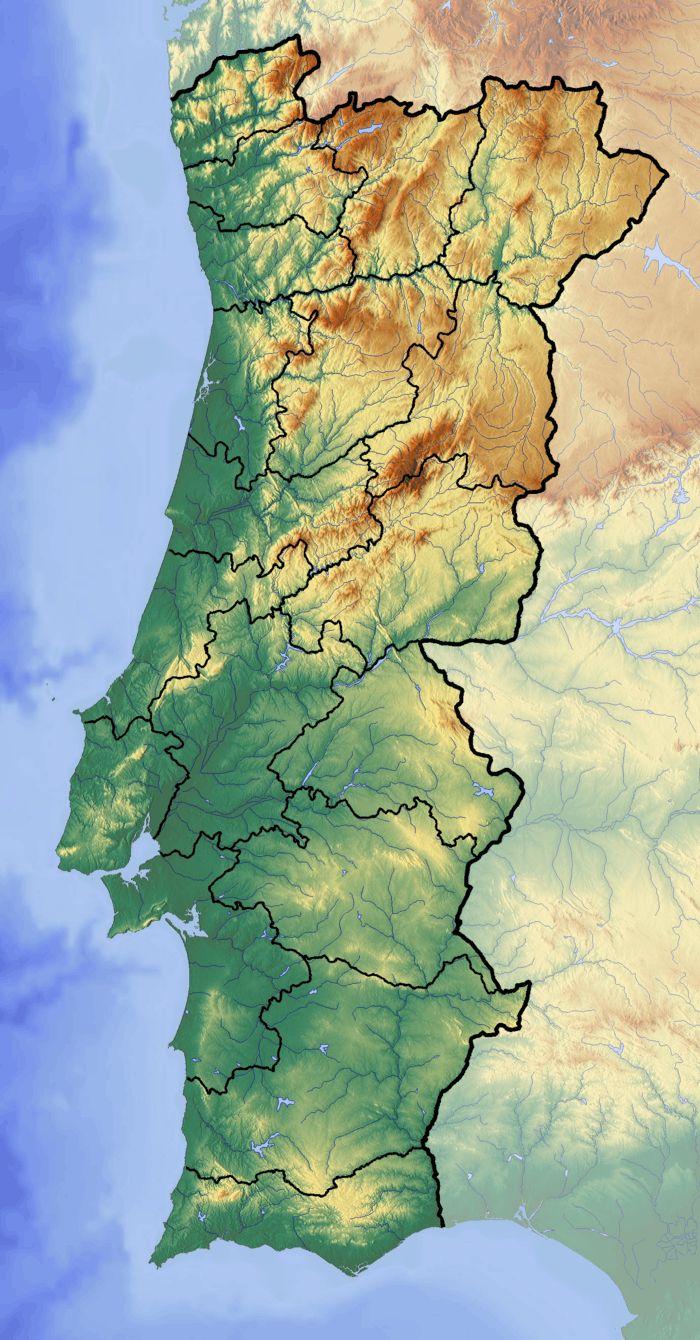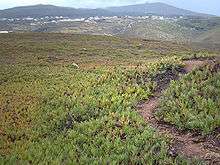Cabo da Roca
Cabo da Roca (Portuguese: [ˈkaβu ðɐ ˈʁɔkɐ]) or Cape Roca is a cape which forms the westernmost point of the Sintra Mountain Range, of mainland Portugal, of continental Europe, and of the Eurasian land mass.[1] It is situated in the municipality of Sintra, near Azóia, in the southwest of the district of Lisbon.
| Cape Roca | |
|---|---|
 The Cabo da Roca lighthouse, overlooking the promontory towards the Atlantic Ocean | |
| Highest point | |
| Peak | Cabo da Roca, Sintra-Cascais Natural Park |
| Elevation | 140 m (460 ft) |
| Coordinates | 38°46′51″N 9°30′2″W |
| Naming | |
| Etymology | roca Portuguese for sea cliff |
| Native name | Cabo da Roca |
| Geography | |
 Cape Roca The location of Cabo da Roca in continental Portugal | |
| Country | |
| Region | Lisboa |
| Subregion | Grande Lisboa |
| District | Lisbon |
| Municipality | Sintra |
| Parent range | Serra da Sintra |
History
Cabo da Roca was known to the Romans as Promontorium Magnum[1] and during the Age of Sail as the Rock of Lisbon.
Geography
_-_Mar_2010.jpg)


The cape is within the Sintra-Cascais Natural Park, 42 kilometres west of the city of Lisbon and in the southwest of Sintra. A location (38°47′N 9°30′W) is inscribed on a stone plaque, located on a monument at the site.
The western coast is a mixture of sandy beaches and rocky cliff promontories: around Cabo da Roca, cliffs are more than 100 metres in height, and cut into crystalline rocks, composed of strongly folded and faulted sedimentary units. These forms are disturbed by dikes and small beaches.[2] This promontory of "high" beaches is the extreme western immersion of the ancient eruptive Sintra massif, as evident from the rose-coloured granite in the north and syenite of the Ribeira do Louriçal in the south. In the vicinity of the Cape, there are geomorphological examples of gabbro-diorite, volcanic breccia, and granite.
Part of the granite formations show evidence of strong coastal erosion, while in other areas there are limestone deposits embedded in the granite.[3]
Much of the vegetation on this cape is low-lying and adapted to saltwater and windy conditions. Once home to a variety of plant life, Cabo da Roca has been overrun with the invasive plant species Carpobrotus edulis. This creeping, mat-forming plant, a member of the Aizoaceae succulent family, was introduced as ground cover by local residents several decades ago, but now covers much of the arable land on Cabo da Roca.
Many migratory and marine birds roost temporarily along the cliffs and protected coves of the coastal area.
See also
References
Notes
- "Cape Roca". Encyclopædia Britannica. 2008. Retrieved 12 August 2008.
- Anja Scheffers and Dieter Kelletat (2005), p.6
- António Oliveira Fonseca (2010), p.11
Sources
- Fonseca, António Oliveira (November 2010), Relatório da Visita ao Parque Natural Sintra-Cascais (PDF) (in Portuguese), Lisbon, Portugal: Universidade Aberta, retrieved 28 September 2011
- Scheffers, Anja; Kelletat, Dieter (2005), "Tsunami Relics on the Coastal Landscape West of Lisbon, Portugal", Science of Tsunami Hazards (PDF), 23, Essen, Germany: University of Duisburg-Essen, pp. 3–16, retrieved 28 September 2011